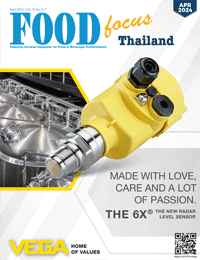กระบวนการผลิตแป้งคาร์บอกซีเมธิลจากข้าวก่ำ Production Process of Purple Rice Carboxymethyl Flour (CMF)
1263 Views |

กระบวนการผลิตแป้งคาร์บอกซีเมธิลจากข้าวก่ำ
Production Process of Purple Rice Carboxymethyl Flour (CMF)
By: ผศ.ดร. สุฐพัศ คำไทย
Assist. Prof. Suthaphat Khamthai, Ph.D.
Department of Packaging Technology
Faculty of Agro-Industry
Lanna Rice Research Center
Chiang Mai University
suthaphat.k@cmu.ac.th
กระบวนการผลิตแป้งคาร์บอกซีเมธิลจากข้าวก่ำ
การผลิตแป้งดัดแปรในกลุ่มคาร์บอกซีเมธิลฟลาวเป็นกระบวนการผลิตแป้งดัดแปรที่ต้องการคงปริมาณแอนโทไซยานินโดยใช้ข้าวก่ำเป็นวัตถุดิบหลัก ทั้งนี้เนื่องจากการคงปริมาณแอนโทไซยานินในกระบวนผลิตแป้งคาร์บอกซีเมธิลจากข้าวก่ำเป็นสิ่งที่ทำได้ยาก หากนำข้าวก่ำมาผลิตเป็นแป้งสีขาว (Starch) เนื่องจากแอนโทไซยานินที่เคลือบอยู่บนผิวของเมล็ดข้าวจะถูกทำลายไประหว่างกระบวนการกำจัดองค์ประกอบทางเคมี เช่น โปรตีน ไขมัน และอื่นๆ ดังนั้น จำเป็นต้องพัฒนากระบวนการผลิตแป้งคาร์บอกซีเมธิลชนิดใหม่จากผงแป้งที่บดจากปลายข้าวก่ำหัก (Purple Broken Rice Flour) โดยประยุกต์จากวิธีการสังเคราะห์โดยใช้กระบวนการผลิตคาร์บอกซีเมธิลสตาร์ช (Carboxymethyl Starch; CMS) ซึ่งใช้ปฏิกิริยาอีเทอริฟิเคชัน (Etherification) เพื่อดัดแปลงโครงสร้างแป้งข้าวก่ำจากการเกิดปฏิกิริยาการแทนที่หมู่ไฮดรอกซิล (Hydroxyl Group; -OH) ในโมเลกุลของน้ำตาลกลูโคสที่เป็นองค์ประกอบในโมเลกุลของแป้งด้วยหมู่คาร์บอกซีเมธิล (-CH2COO-) จากปฏิกิริยาอีเทอริฟิเคชัน จึงทำให้แป้งคาร์บอกซีเมธิลมีสมบัติที่แตกต่างไปจากแป้งคาร์บอกซีเมธิลอื่นๆ โดยปฏิกิริยาอีเทอริฟิเคชันจะทำให้คาร์บอกซีเมธิลฟลาวมีสมบัติที่แตกต่างไปจากคาร์บอกซีเมธิลสตาร์ชจากแป้งธรรมชาติ (Native Starch) ซึ่งสมบัติที่สำคัญ ได้แก่ การมีปริมาณแอนโทไซยานินสูง ซึ่งทำให้อุณหภูมิในการเกิดเจลาติไนเซชัน (Gelatinization Temperature) ต่ำลง สามารถละลายในน้ำเย็นได้ดีขึ้น และเกิดอัตราการคืนตัว (Retrogradation) ที่ดีขึ้นอีกด้วย
จากผลการวิจัยการสังเคราะห์คาร์บอกซีเมธิลฟลาวจากข้าวก่ำจำนวน 5 สายพันธุ์ ได้แก่ ข้าวก่ำเจ้า มช 107 ข้าวก่ำลืมผัว ข้าวก่ำดอยสะเก็ด ข้าวก่ำสันกำแพง และข้าวก่ำห้วยฮ่องไคร้ โดยอ้างอิงกรรมวิธีจากสิทธิบัตรเลขที่ 95850 (ภาพที่ 2) เรื่องกระบวนการผลิตแป้งคาร์บอกซีเมธิลจากข้าวก่ำ พบว่าค่าระดับการแทนที่ของคาร์บอกซีเมธิลฟลาวจากข้าวทั้ง 5 สายพันธุ์อยู่ในช่วง 0.3–0.45 มีค่าร้อยละของปริมาณ CMF อยู่ในช่วงร้อยละ 80-87 มีรูปร่างทรงกลมที่มีขนาดอนุภาคอยู่ในช่วง 15–30 ไมโครเมตร (ภาพที่ 3) และมีปริมาณแอนโทไซยานิน (Cyanidin-3-glucoside) อยู่ในช่วง 37–226 มิลลิกรัมต่อ 100 กรัม โดยคาร์บอกซีเมธิลฟลาวจากข้าวก่ำลืมผัวมีปริมาณแอนโทไซยานินสูงที่สุดซึ่งมีค่าเท่ากับ 226.65 มิลลิกรัมต่อ 100 กรัม และรองลงมา คือ คาร์บอกซีเมธิลฟลาวจากข้าวก่ำเจ้า มช. 107 ซึ่งมีค่าเท่ากับ 99 มิลลิกรัมต่อ 100 กรัม สำหรับค่าสีของคาร์บอกซีเมธิลฟลาวจากข้าวก่ำที่สังเคราะห์ได้ พบว่ามีสีม่วงอ่อนถึงม่วงเข้มแตกต่างกัน ซึ่งขึ้นอยู่กับปริมาณของแอนโทไซยานินที่เหลืออยู่ภายหลังจากการสังเคราะห์ข้าวสายพันธุ์ต่างๆ แสดงดังภาพที่ 4 ตัวอย่าง CMF จากข้าวก่ำเจ้า มช. 107 (ก) ข้าวก่ำลืมผัว (ข) ข้าวก่ำดอยสะเก็ด (ค) ข้าวก่ำสันกำแพง (ง) และข้าวก่ำห้วยฮ่องไคร้ (จ) ตามลำดับ
Production Process of Purple Rice Carboxymethyl Flour
Because anthocyanin preservation in the production process of carboxymethyl flour is difficult to achieve, a viable solution is to rely mainly on purple rice. When purple rice is used to make white flour, the anthocyanin content on the grain surface will also be eliminated by the processes initially designed to remove chemical compounds such as protein, fat, and other substances. Hence, it is necessary to develop a new technique to produce carboxymethyl flour from purple broken rice flour. The new method is based on the synthesis of carboxymethyl starch (CMS), which uses etherification to modify the structure of purple rice flour from the substitution of the hydroxyl group (-OH) in the molecules of glucose – a compound of starch molecules. During this process, the hydroxyl group is substituted by the carboxymethyl group (-CH2COO-) through etherification, consequently imbuing the carboxymethyl flour with novel properties that are different from those of other types of carboxymethyl flour. The etherification yields properties different from those of carboxymethyl starch produced from native starch. One of the key features is, as a result, high anthocyanin content, which can lower gelatinization temperature, improve solubility in cool water, and enhance retrogradation.
In the research, carboxymethyl flour was synthesized from 5 varieties of purple rice, including Kum Chao CMU 107, Leum Pua, Doi Saket, San Kamphaeng, and Huai Hongkhrai, via the synthesis process registered in the Patent No. 95850 (Figure 2) regarding the production process of carboxymethyl flour from purple rice. The study revealed that the degree of substitution from all five varieties ranged between 0.3 and 0.45, the quantity of CMF was at 80-87%, the round-shaped particle size of CMF ranged from 15 to 30 micrometers (Figure 3), and the amount of cyanidin-3-glucoside was at 37-226 milligrams per 100 grams. The CMF from Leum Pua rice variety exhibited the highest anthocyanin content of 226.65 milligrams per 100 grams, while the second highest content was found in Kum Chao CMU 107, which contained 99 milligrams of anthocyanin per 100 grams. The synthesized CMF had different hues of color, from light to deep purple, depending on the concentration of anthocyanin that remained after the production process. Figure 4 shows CMF produced from Kum Chao CMU 107, Luem Pua (B), Doi Saket (C), San Kamphaeng (D), and Huai Hongkhrai (E), respectively.






